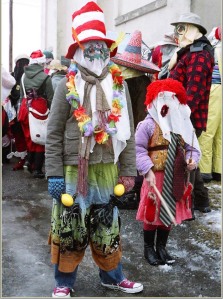Christmas traditions are a little like bulbs on a tree. Some are old, some are new; some are ubiquitous and others unique. Some turn up every December and others disappear – either for good or only to return years later, rediscovered by nostalgic Christmas revelers. Like heavily decorated trees, we’re under the weight of our traditions for twelve long days.
Many Newfoundlanders and Labradorians engage in the same traditions that are commonplace across North America and the United Kingdom. Carols are sung, stockings are hung, and lights are strung. But there are also those rare traditions that are special or unique to the province. The most well-known is mummering or jannying, which the Dictionary of Newfoundland English defines as: ‘The practice of visiting houses disguised as a mummer at Christmas’.
This tradition was prevalent in Britain by the 15th century and was later brought to the island of Newfoundland by English settlers. The earliest recorded usage in the Oxford English Dictionary is from 1417: “[There shall be no] mummyng [during this Feast of Our Lord’s Nativity]” (from Henry T. Riley’s Memorials of London and London Life – In the 13th, 14th and 15th Centuries).
In contrast, the DNE’s earliest recorded direct reference to Christmas mummering did not appear for another 400 years, when the Royal Gazette printed on 23 January 1812 that: “Mr Michael Wall, who took an active part in forming and practising the MUMMERS that assembled on last twelfth day, appeared in the character of a General Officer, with his Lady.”
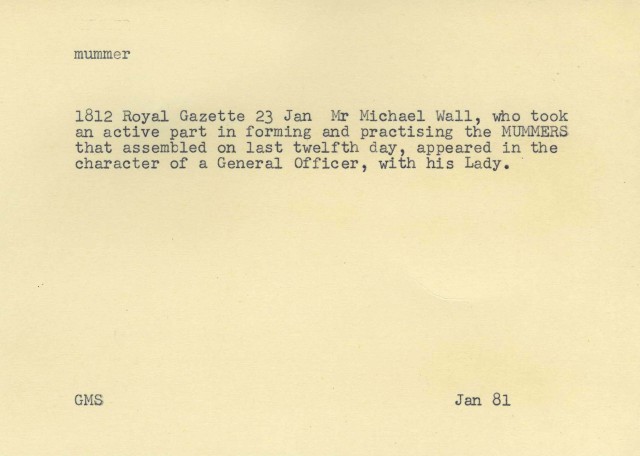
The earliest recorded direct reference to mummering in the DNE. Reproduced by permission of the English Language Research Centre, Memorial University, St. John’s, NL.
Mummers remained a staple of the Christmas season in rural Newfoundland and Labrador for the next 150 years, but fell into relative obscurity during the 1960s. One theory is that the growing popularity of wall-to-wall carpeting made homeowners suddenly reluctant to have troupes of mummers stomp all over their hard-to-clean floors. Another is that the introduction of roads and television pushed the activity into decline – homeowners could no longer be sure that their masked visitors came from within the community, and exposure to televised stories of crime and violence made them more hesitant than ever before to let complete strangers into their homes.
By the 1980s and 1990s, however, the tradition was back in the good graces and living rooms of local residents, buoyed by nostalgia for a vanishing way of life and the invention of laminate flooring. The tradition has not only left its mark on Newfoundland and Labrador culture, but on its language as well. The DNE lists at least ten synonyms for the noun mummer, including darby, dark one, fool, geezer, janny, morgan, naluyuk, ownshook, teak, and white boy.
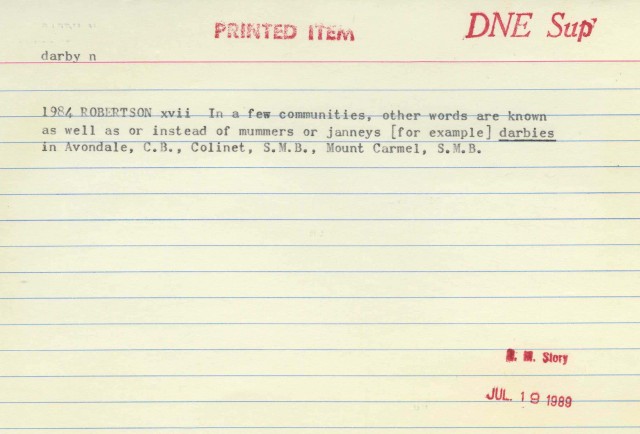
Darby is one of several synonyms for the word mummer in Newfoundland English. The quotation on this word-file appears in the Supplement to the DNE, published in 1990. Reproduced by permission of the English Language Research Centre, Memorial University, St. John’s, NL.
Some terms did not originate in Newfoundland and Labrador, and were instead brought here by English and Irish settlers in the 1800s. Mummer, for example, is an English word and ownshook an Irish one. There is, however, an important difference in how these words evolved after reaching the colony: mummer retained the same definition it had in Britain, while ownshook developed a new meaning distinctively characteristic of Newfoundland usage.
In Ireland, ownshook simply meant ‘a foolish, ignorant person’, but by the late-19th century, Newfoundland speakers also used it to denote ‘a Christmas mummer’. This sense of the word appears to have originated here, with its earliest known recorded usage appearing in an 1885 issue of the Evening Telegram. This is supported by the Oxford English Dictionary, which also cites the Telegram as its first entry for this sense of ownshook and gives the following definition: ‘Newfoundland. Any of a number of men, usually dressed in women’s clothes, who participated in a mummers’ parade at Christmas. Now hist.’
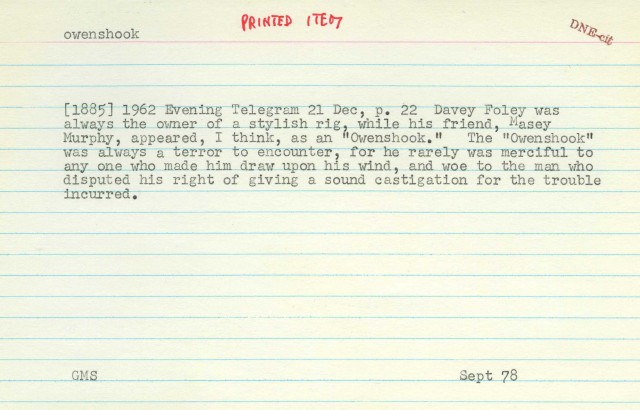
This word-file cites the earliest known recorded usage for this sense of ownshook. The DNE lists several variant spellings for ownshook: eunchuck, oanshick, onshook, oonchook, oonshik, and owenshook. Reproduced by permission of the English Language Research Centre, Memorial University, St. John’s, NL.
Other terms are unique to the province. One example is naluyuk, the Inuit word for mummer. Another is janny, which the OED defines as ‘A Christmas mummer in Newfoundland.’ The DNE lists four variant spellings: janney, jannie, jonny, and jenny. There are also word combinations, such as janny-night (any night during the Christmas season on which jannies go around visiting at people’s houses) and janny-talk (the distorted speech a janny uses to disguise his or her identity).
A word combination that did not appear in the DNE, but is treated in its word-files is last year’s jannie: a lazy mummer who tries to get away with wearing the same costume two years in a row, or who wears a disguise so flimsy that it cannot hide his or her identity. The phrase only appears on a single word-file, so the editors may have omitted it due to a scarcity of supporting evidence.
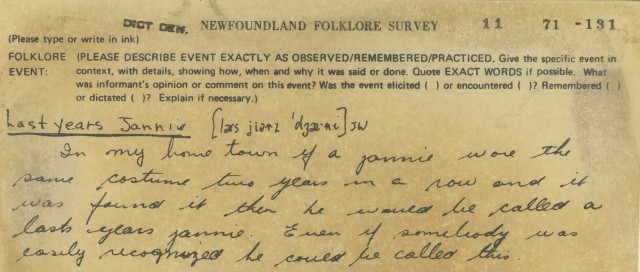
Recorded in 1971, this is the only word-file that exists for ‘last year’s jannie’ in the DNE Collection. “In my home town if a jannie wore the same costume two years in a row and it was found it then he would be called a lasts years jannie. Even if somebody was easily recognized he could be called this.” The town the speaker refers to is Islington, on Newfoundland’s east coast in Trinity Bay. Reproduced by permission of the English Language Research Centre, Memorial University, St. John’s, NL.
The DNE also has many entries that relate to a mummer’s disguise (known as a fit-out or rig) and anyone looking for costume ideas will find a wealth of information in its pages or online search engine. As the word-file below indicates, a mask, or false face, is an important part of any quality fit-out – it hides one’s identity and adds panache. These are often homemade, but may also be store bought. Some mummers prefer the pared down elegance of a simple veil; others the flamboyant glamour of a false beard and giant nose.
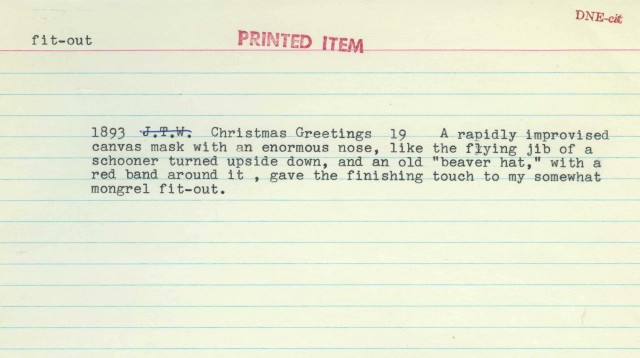
A word-file for fit-out from the ELRC's DNE Collection. Reproduced by permission of the English Language Research Centre, Memorial University, St. John’s, NL.
Accessories are also important. Humps and bumps are greatly encouraged. They come in all sizes and can go pretty much anywhere. Among the most popular accessory, however, is the hobby horse or horsy-hops – a figure of a horse carried by mummers during Christmas festivities. According to the word-file below, which was recorded in 1971, the hobby horse may also resemble a cow or moose and was sometimes a costume in its own right, large enough to enclose several mummers.
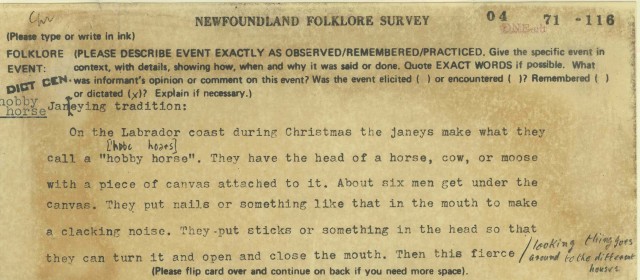
Recorded in 1971. “Janeying tradition: On the Labrador coast during Christmas the janeys make what they call a "hobby horse". They have the head of a horse, cow, or moose with a piece of canvas attached to it. About six men get under the canvas. They put nails or something like that in the mouth to make a clacking noise. They put sticks or something in the head so that they can turn it and open and close the mouth. Then this fierce/ looking thing goes around to the different houses.” Reproduced by permission of the English Language Research Centre, Memorial University, St. John’s, NL.
Interestingly, the hobby horse made its first recorded appearance here long before Christmas mummering became an annual event. In 1583, English explorer Sir Humphrey Gilbert and his crew brought “Morris dancers, Hobby horsse, and Maylike conceits” to the island. These were items and activities that Gilbert hoped would improve relations – both diplomatic and commercial – with Newfoundland’s indigenous peoples.
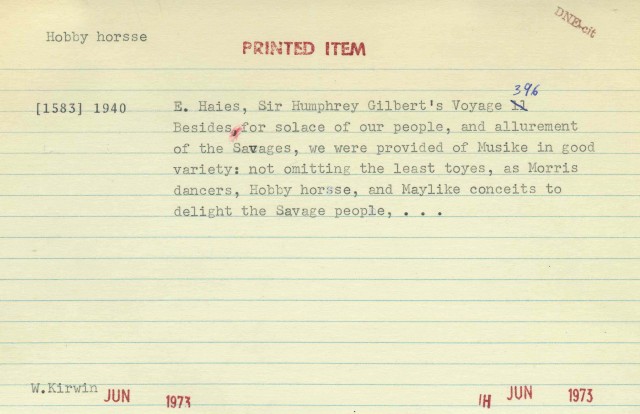
The earliest known appearance of a hobby horse on the island of Newfoundland. Reproduced by permission of the English Language Research Centre, Memorial University, St. John’s, NL.
Another accessory worthy of consideration, although perhaps difficult to obtain, is the bladder, which the DNE defines as ‘an inflated animal bladder used as a mock weapon by Christmas mummers’. If you feel shy about dragging one of these around town, then why not accessorize with a musical instrument? Our most dashing of mummers have for generations sported accordions, guitars, spoons, and harmonicas – when put to good use they may even earn a last year’s jannie a glass of wine and piece of cake.

